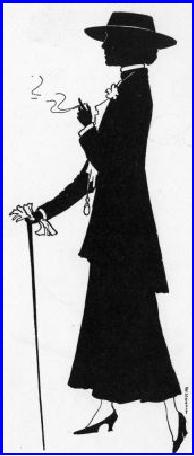 |
MARK TWAIN'S LOVE OF COLOUR IN ALL COSTUMING |
| << STUDYING LINE AND COLOUR IN RUSSIA |
| THE ARTIST AND HIS COSTUME >> |

The
setting sun streamed through
the ancient stained glass, dyeing
their dirty
sheepskin
crimson, and purple, and green,
until they looked like
illuminations in
old
missals. To the eye and the
mind of western Europe it was
all
incomprehensible.
Yet those were the people of Russia who
are to-day her mass
of
armed
defenders; the element that
has been counted on from
the first by Russia and
her
allies stood penniless before an altar
laid over with gold
and silver and
precious
stones.
Just before we got to Kiev, one of those
men in sheepskins with uncut
hair
and
dogged expression, who had a
sense of values in human
existence, broke into
the
church and stole jeweled
chalices from the altar.
They were traced to a
pawnshop
in a distant city and brought back. It
was a common thing to see
men halt
in
the street and stand uncovered, while a
pitiful funeral cortege passed. A
wooly,
half-starved,
often lame horse, was harnessed
with rope to a simple
four-wheeled
farm
wagon, a long-haired peasant at
his head, women and children
holding to the
sides
of the cart as they stumbled
along in grief, and inside a
rough wooden coffin
covered
with a black pall, on which
was sewn the Greek cross, in
white. Heartless,
hopeless,
weary and underfed, those peasants
were taking their dead to be
blessed
for
a price, by the priest in
cloth of gold, without whose
blessing there could be
no
burial.
CHAPTER
XXIII
MARK
TWAIN'S LOVE OF COLOUR IN ALL
COSTUMING
HE
public
thinks of Mark Twain as
being the apostle of white
during
the
last
years of his life, but those
who knew him well
recall his
delightfully
original
way of expressing an intense
love for bright
colours. This
brings
to
mind a week-end at Mark
Twain's beautiful Italian
villa in Reading,
Connecticut,
when, one night during
dinner, he held forth on the
compelling
fascination
of colours and the American
Indian's superior judgment in
wearing
them.
After a lengthy elaboration--not to say
exaggeration--of his theme,
he
ended
by declaring in uncompromising terms,
that colour, and plenty of
it, crimson
and
yellow and blue, wrapped
around man, as well as
woman, was an
obligation
shirked
by humanity. It was all put as
only Mark Twain could
have put it, with
that
serious
vein showing through broad
humour. This quality
combined with an
unmatched
originality, made every
moment passed in his company
a memory to
treasure.
It was not alone his
theme, but how he dealt
with it, that fascinated
one.
PLATE
XXIX
One
of the 1917
silhouettes.
Naturally,
since woman to-day dresses
for her
occupation--work
or play--the characteristic
silhouettes
are many.
This
one is reproduced to illustrate our
point
that
outline can be affected by the
smallest
detail.

The
sketch is by Elisabeth
Searcy.
Drawn
from Life by
Elisabeth
Searcy A
Modern
Silhouette--
1917
Tailor-made
Mark
Twain was elemental and at the
same time a great artist,--the
embodiment of
extreme
contradictions, and his flair
for gay colour was one proof
of his elemental
strain.
We laughed that night as he
made word pictures of how
men and women
should
dress. Next morning, toward
noon, on looking out of a
window, we saw
standing
in the middle of the
driveway a figure wrapped in
crimson silk, his
white
hair
flying in the wind, while
smoke from a pipe encircled his
head. Yes, it was
Mark
Twain, who in the midst of
his writing, had been
suddenly struck with
the
thought
that the road needed
mending, and had gone out to
have another look at
it!
It
was a blustering day in
Spring, and cold, so one of the
household was sent to
persuade
him to come in. We can see
him now, returning
reluctantly, wind-blown
and
vehement, gesticulating, and stopping
every few steps to express
his opinion of
the
men who had made
that road! The flaming
red silk robe he wore was
one his
daughter
had brought him from
Liberty's, in London, and he adored
it. Still
wrapped
in it, and seemingly unconscious of
his unusual appearance, he
joined us
on
the balcony, to resume a conversation of
the night before.
The
red-robed figure seated itself in a
wicker chair and berated the
idea that mortal
man
ever could
be
generous,--act without selfish
motives. With the
greatest
reverence
in his tone, sitting there
in his whimsical costume of
bright red silk, at
high
noon,--an immaculate French
butler waiting at the door
to announce lunch,
Table of Contents:
- A FEW HINTS FOR THE NOVICE WHO WOULD PLAN HER COSTUMES
- THE LAWS UNDERLYING ALL COSTUMING OF WOMAN
- HOW TO DRESS YOUR TYPE
- THE PSYCHOLOGY OF CLOTHES
- ESTABLISH HABITS OF CARRIAGE WHICH CREATE GOOD LINE
- COLOUR IN WOMAN'S COSTUME
- FOOTWEAR
- JEWELRY AS DECORATION
- WOMAN DECORATIVE IN HER BOUDOIR
- WOMAN DECORATIVE IN HER SUN-ROOM
- I. WOMAN DECORATIVE IN HER GARDEN:WOMAN DECORATIVE ON THE LAWN
- WOMAN AS DECORATION WHEN SKATING
- WOMAN DECORATIVE IN HER MOTOR CAR
- HOW TO GO ABOUT PLANNING A PERIOD COSTUME
- I. THE STORY OF PERIOD COSTUMES:II. EGYPT AND ASSYRIA
- DEVELOPMENT OF GOTHIC COSTUME
- THE RENAISSANCE
- EIGHTEENTH CENTURY
- WOMAN IN THE VICTORIAN PERIOD
- SEX IN COSTUMING
- LINE AND COLOUR OF COSTUMES IN HUNGARY
- STUDYING LINE AND COLOUR IN RUSSIA
- MARK TWAIN'S LOVE OF COLOUR IN ALL COSTUMING
- THE ARTIST AND HIS COSTUME
- IDIOSYNCRASIES IN COSTUME
- NATIONALITY IN COSTUME
- MODELS
- WOMAN COSTUMED FOR HER WAR JOB
- IN CONCLUSION